Analysis of Leptin Hormone and Leptin Receptor Interaction
VerifiedAdded on 2022/08/12
|6
|1297
|14
Homework Assignment
AI Summary
This paper delves into the intricate relationship between the hormone leptin and its receptor, examining their functions, importance, and cellular interactions within the body. It begins by identifying leptin and the leptin receptor as the protein-ligand pair, highlighting leptin's role in regulating satiety and energy balance. The paper then explores the primary biological functions resulting from their interaction, including reduced hunger, increased satiety, and regulation of energy expenditure. It further discusses the key cellular pathways, such as the hypothalamus and central nervous system, involved in these processes. At the molecular level, the paper describes the interaction across various domains of the leptin receptor, emphasizing the role of specific protein residues. Finally, it examines the interaction at both cellular and tissue levels, including the hypothalamus and hippocampus regions of the brain. The paper concludes by summarizing the key functions and impacts of this crucial interaction, supported by a comprehensive list of references.
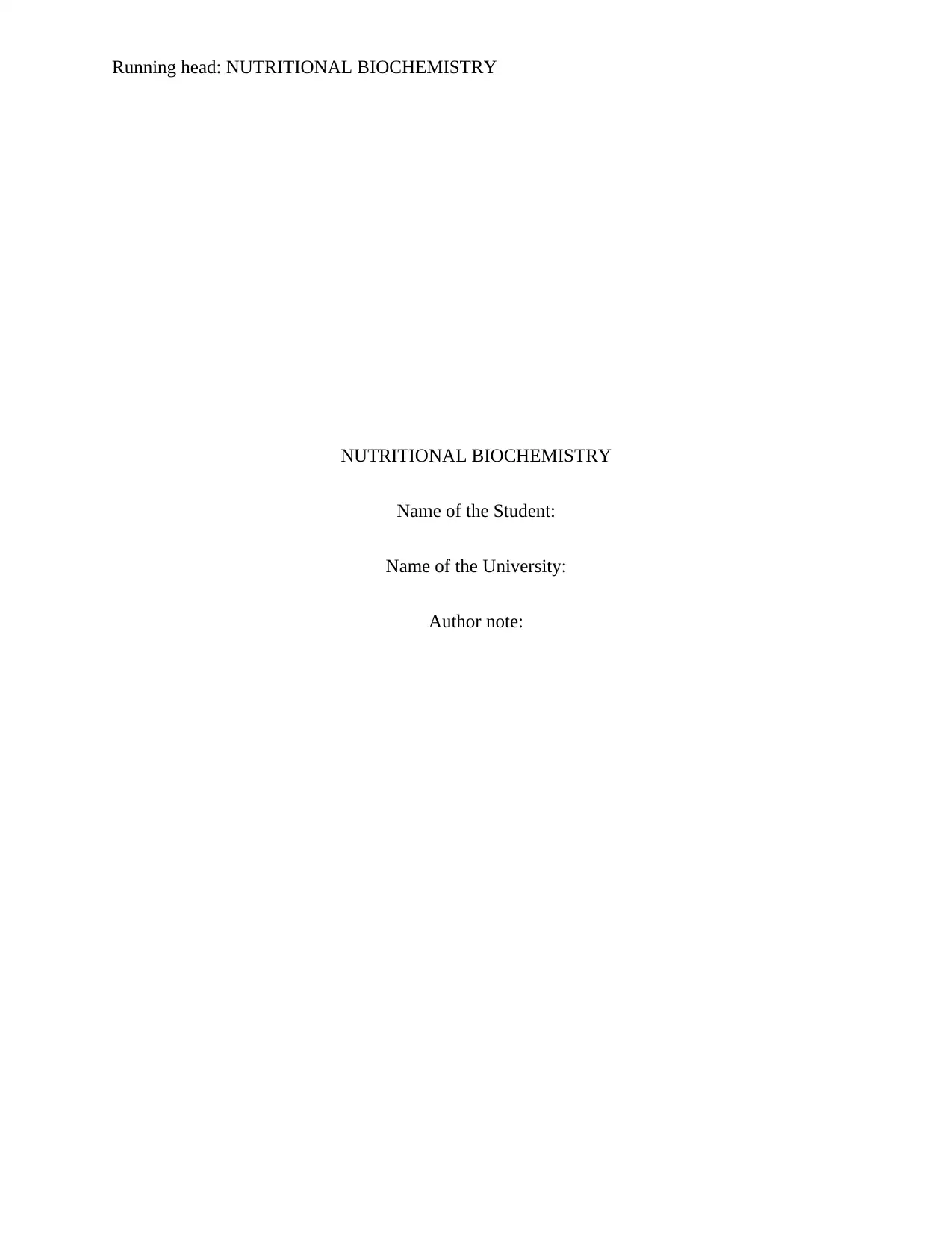
Running head: NUTRITIONAL BIOCHEMISTRY
NUTRITIONAL BIOCHEMISTRY
Name of the Student:
Name of the University:
Author note:
NUTRITIONAL BIOCHEMISTRY
Name of the Student:
Name of the University:
Author note:
Paraphrase This Document
Need a fresh take? Get an instant paraphrase of this document with our AI Paraphraser
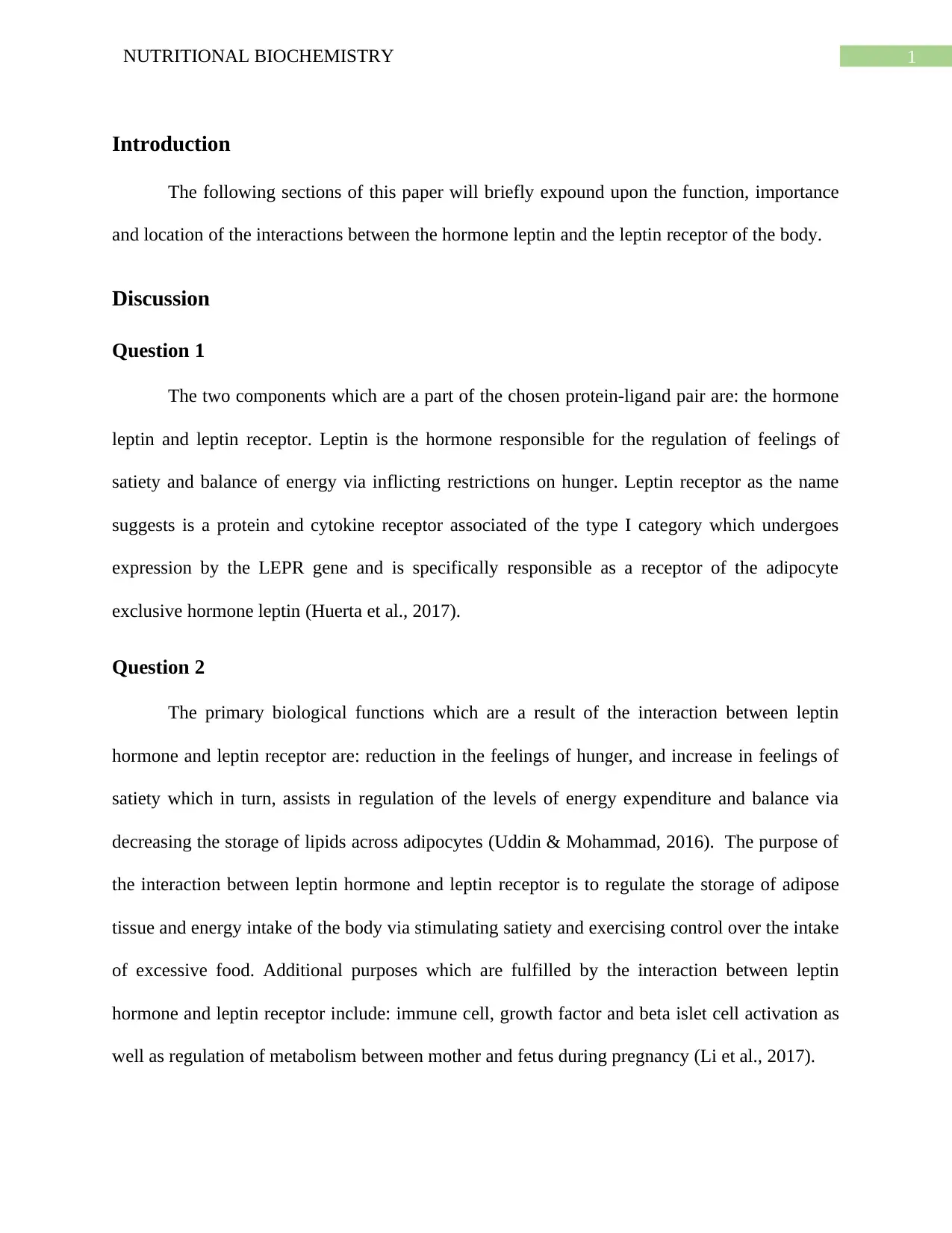
1NUTRITIONAL BIOCHEMISTRY
Introduction
The following sections of this paper will briefly expound upon the function, importance
and location of the interactions between the hormone leptin and the leptin receptor of the body.
Discussion
Question 1
The two components which are a part of the chosen protein-ligand pair are: the hormone
leptin and leptin receptor. Leptin is the hormone responsible for the regulation of feelings of
satiety and balance of energy via inflicting restrictions on hunger. Leptin receptor as the name
suggests is a protein and cytokine receptor associated of the type I category which undergoes
expression by the LEPR gene and is specifically responsible as a receptor of the adipocyte
exclusive hormone leptin (Huerta et al., 2017).
Question 2
The primary biological functions which are a result of the interaction between leptin
hormone and leptin receptor are: reduction in the feelings of hunger, and increase in feelings of
satiety which in turn, assists in regulation of the levels of energy expenditure and balance via
decreasing the storage of lipids across adipocytes (Uddin & Mohammad, 2016). The purpose of
the interaction between leptin hormone and leptin receptor is to regulate the storage of adipose
tissue and energy intake of the body via stimulating satiety and exercising control over the intake
of excessive food. Additional purposes which are fulfilled by the interaction between leptin
hormone and leptin receptor include: immune cell, growth factor and beta islet cell activation as
well as regulation of metabolism between mother and fetus during pregnancy (Li et al., 2017).
Introduction
The following sections of this paper will briefly expound upon the function, importance
and location of the interactions between the hormone leptin and the leptin receptor of the body.
Discussion
Question 1
The two components which are a part of the chosen protein-ligand pair are: the hormone
leptin and leptin receptor. Leptin is the hormone responsible for the regulation of feelings of
satiety and balance of energy via inflicting restrictions on hunger. Leptin receptor as the name
suggests is a protein and cytokine receptor associated of the type I category which undergoes
expression by the LEPR gene and is specifically responsible as a receptor of the adipocyte
exclusive hormone leptin (Huerta et al., 2017).
Question 2
The primary biological functions which are a result of the interaction between leptin
hormone and leptin receptor are: reduction in the feelings of hunger, and increase in feelings of
satiety which in turn, assists in regulation of the levels of energy expenditure and balance via
decreasing the storage of lipids across adipocytes (Uddin & Mohammad, 2016). The purpose of
the interaction between leptin hormone and leptin receptor is to regulate the storage of adipose
tissue and energy intake of the body via stimulating satiety and exercising control over the intake
of excessive food. Additional purposes which are fulfilled by the interaction between leptin
hormone and leptin receptor include: immune cell, growth factor and beta islet cell activation as
well as regulation of metabolism between mother and fetus during pregnancy (Li et al., 2017).
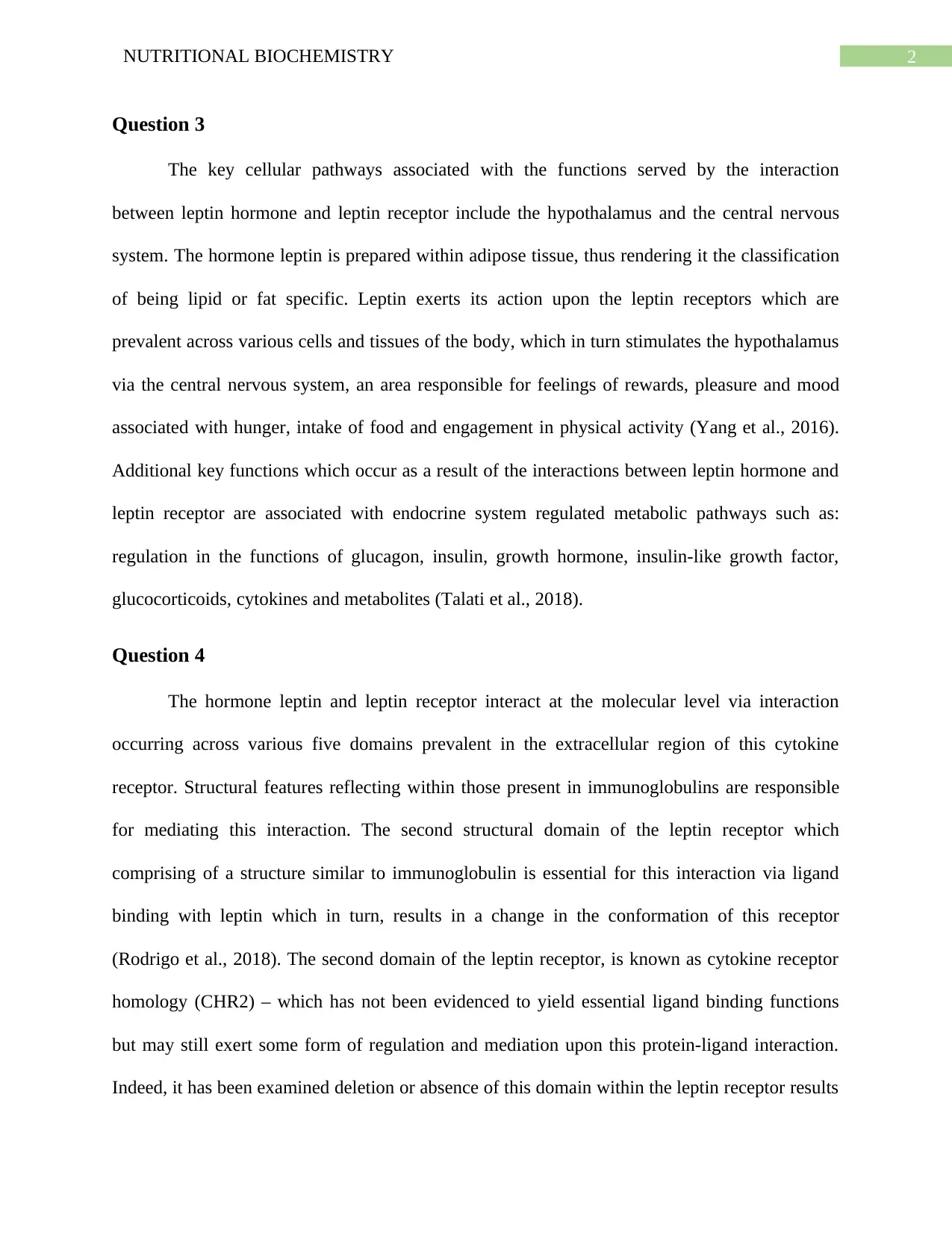
2NUTRITIONAL BIOCHEMISTRY
Question 3
The key cellular pathways associated with the functions served by the interaction
between leptin hormone and leptin receptor include the hypothalamus and the central nervous
system. The hormone leptin is prepared within adipose tissue, thus rendering it the classification
of being lipid or fat specific. Leptin exerts its action upon the leptin receptors which are
prevalent across various cells and tissues of the body, which in turn stimulates the hypothalamus
via the central nervous system, an area responsible for feelings of rewards, pleasure and mood
associated with hunger, intake of food and engagement in physical activity (Yang et al., 2016).
Additional key functions which occur as a result of the interactions between leptin hormone and
leptin receptor are associated with endocrine system regulated metabolic pathways such as:
regulation in the functions of glucagon, insulin, growth hormone, insulin-like growth factor,
glucocorticoids, cytokines and metabolites (Talati et al., 2018).
Question 4
The hormone leptin and leptin receptor interact at the molecular level via interaction
occurring across various five domains prevalent in the extracellular region of this cytokine
receptor. Structural features reflecting within those present in immunoglobulins are responsible
for mediating this interaction. The second structural domain of the leptin receptor which
comprising of a structure similar to immunoglobulin is essential for this interaction via ligand
binding with leptin which in turn, results in a change in the conformation of this receptor
(Rodrigo et al., 2018). The second domain of the leptin receptor, is known as cytokine receptor
homology (CHR2) – which has not been evidenced to yield essential ligand binding functions
but may still exert some form of regulation and mediation upon this protein-ligand interaction.
Indeed, it has been examined deletion or absence of this domain within the leptin receptor results
Question 3
The key cellular pathways associated with the functions served by the interaction
between leptin hormone and leptin receptor include the hypothalamus and the central nervous
system. The hormone leptin is prepared within adipose tissue, thus rendering it the classification
of being lipid or fat specific. Leptin exerts its action upon the leptin receptors which are
prevalent across various cells and tissues of the body, which in turn stimulates the hypothalamus
via the central nervous system, an area responsible for feelings of rewards, pleasure and mood
associated with hunger, intake of food and engagement in physical activity (Yang et al., 2016).
Additional key functions which occur as a result of the interactions between leptin hormone and
leptin receptor are associated with endocrine system regulated metabolic pathways such as:
regulation in the functions of glucagon, insulin, growth hormone, insulin-like growth factor,
glucocorticoids, cytokines and metabolites (Talati et al., 2018).
Question 4
The hormone leptin and leptin receptor interact at the molecular level via interaction
occurring across various five domains prevalent in the extracellular region of this cytokine
receptor. Structural features reflecting within those present in immunoglobulins are responsible
for mediating this interaction. The second structural domain of the leptin receptor which
comprising of a structure similar to immunoglobulin is essential for this interaction via ligand
binding with leptin which in turn, results in a change in the conformation of this receptor
(Rodrigo et al., 2018). The second domain of the leptin receptor, is known as cytokine receptor
homology (CHR2) – which has not been evidenced to yield essential ligand binding functions
but may still exert some form of regulation and mediation upon this protein-ligand interaction.
Indeed, it has been examined deletion or absence of this domain within the leptin receptor results
⊘ This is a preview!⊘
Do you want full access?
Subscribe today to unlock all pages.

Trusted by 1+ million students worldwide
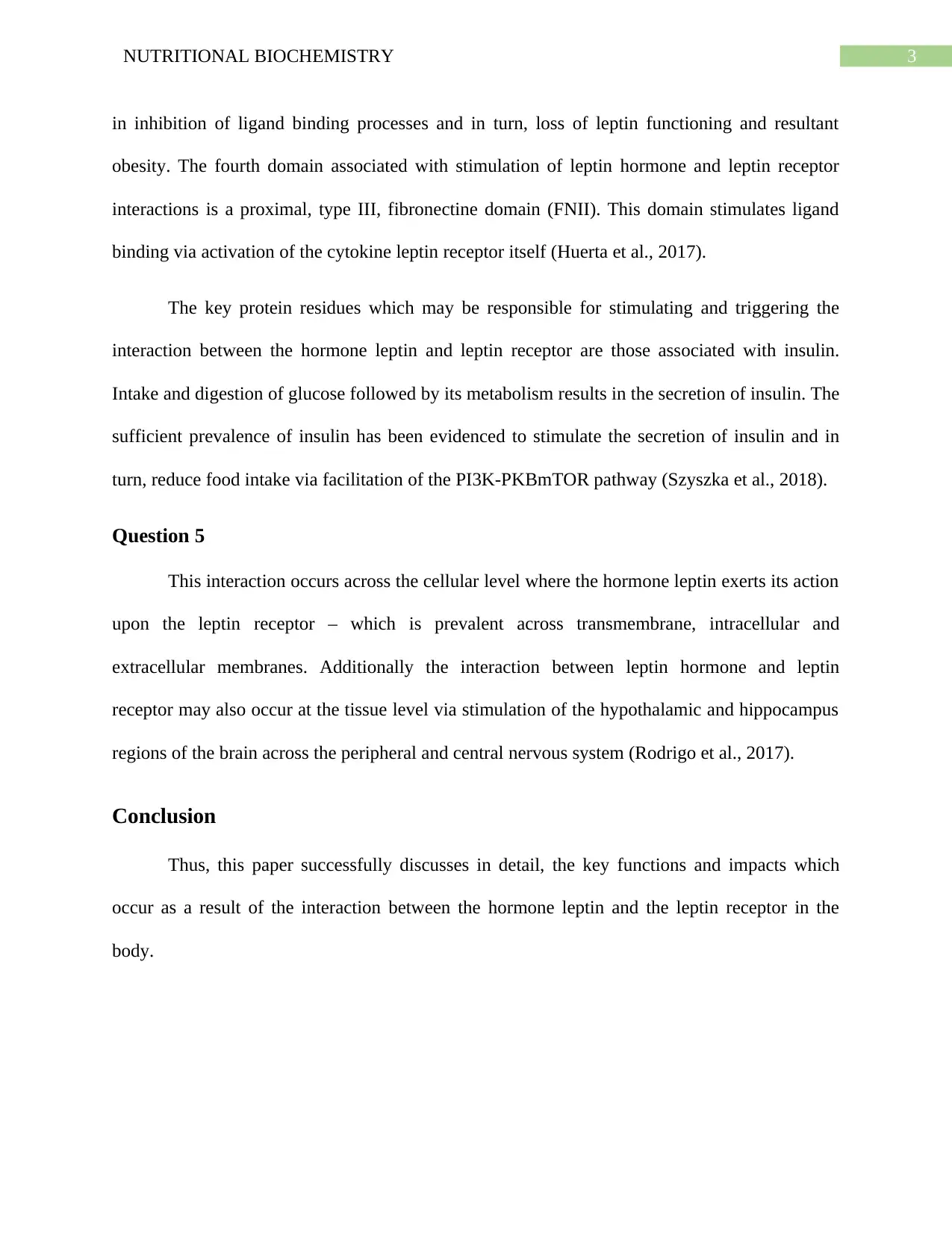
3NUTRITIONAL BIOCHEMISTRY
in inhibition of ligand binding processes and in turn, loss of leptin functioning and resultant
obesity. The fourth domain associated with stimulation of leptin hormone and leptin receptor
interactions is a proximal, type III, fibronectine domain (FNII). This domain stimulates ligand
binding via activation of the cytokine leptin receptor itself (Huerta et al., 2017).
The key protein residues which may be responsible for stimulating and triggering the
interaction between the hormone leptin and leptin receptor are those associated with insulin.
Intake and digestion of glucose followed by its metabolism results in the secretion of insulin. The
sufficient prevalence of insulin has been evidenced to stimulate the secretion of insulin and in
turn, reduce food intake via facilitation of the PI3K-PKBmTOR pathway (Szyszka et al., 2018).
Question 5
This interaction occurs across the cellular level where the hormone leptin exerts its action
upon the leptin receptor – which is prevalent across transmembrane, intracellular and
extracellular membranes. Additionally the interaction between leptin hormone and leptin
receptor may also occur at the tissue level via stimulation of the hypothalamic and hippocampus
regions of the brain across the peripheral and central nervous system (Rodrigo et al., 2017).
Conclusion
Thus, this paper successfully discusses in detail, the key functions and impacts which
occur as a result of the interaction between the hormone leptin and the leptin receptor in the
body.
in inhibition of ligand binding processes and in turn, loss of leptin functioning and resultant
obesity. The fourth domain associated with stimulation of leptin hormone and leptin receptor
interactions is a proximal, type III, fibronectine domain (FNII). This domain stimulates ligand
binding via activation of the cytokine leptin receptor itself (Huerta et al., 2017).
The key protein residues which may be responsible for stimulating and triggering the
interaction between the hormone leptin and leptin receptor are those associated with insulin.
Intake and digestion of glucose followed by its metabolism results in the secretion of insulin. The
sufficient prevalence of insulin has been evidenced to stimulate the secretion of insulin and in
turn, reduce food intake via facilitation of the PI3K-PKBmTOR pathway (Szyszka et al., 2018).
Question 5
This interaction occurs across the cellular level where the hormone leptin exerts its action
upon the leptin receptor – which is prevalent across transmembrane, intracellular and
extracellular membranes. Additionally the interaction between leptin hormone and leptin
receptor may also occur at the tissue level via stimulation of the hypothalamic and hippocampus
regions of the brain across the peripheral and central nervous system (Rodrigo et al., 2017).
Conclusion
Thus, this paper successfully discusses in detail, the key functions and impacts which
occur as a result of the interaction between the hormone leptin and the leptin receptor in the
body.
Paraphrase This Document
Need a fresh take? Get an instant paraphrase of this document with our AI Paraphraser
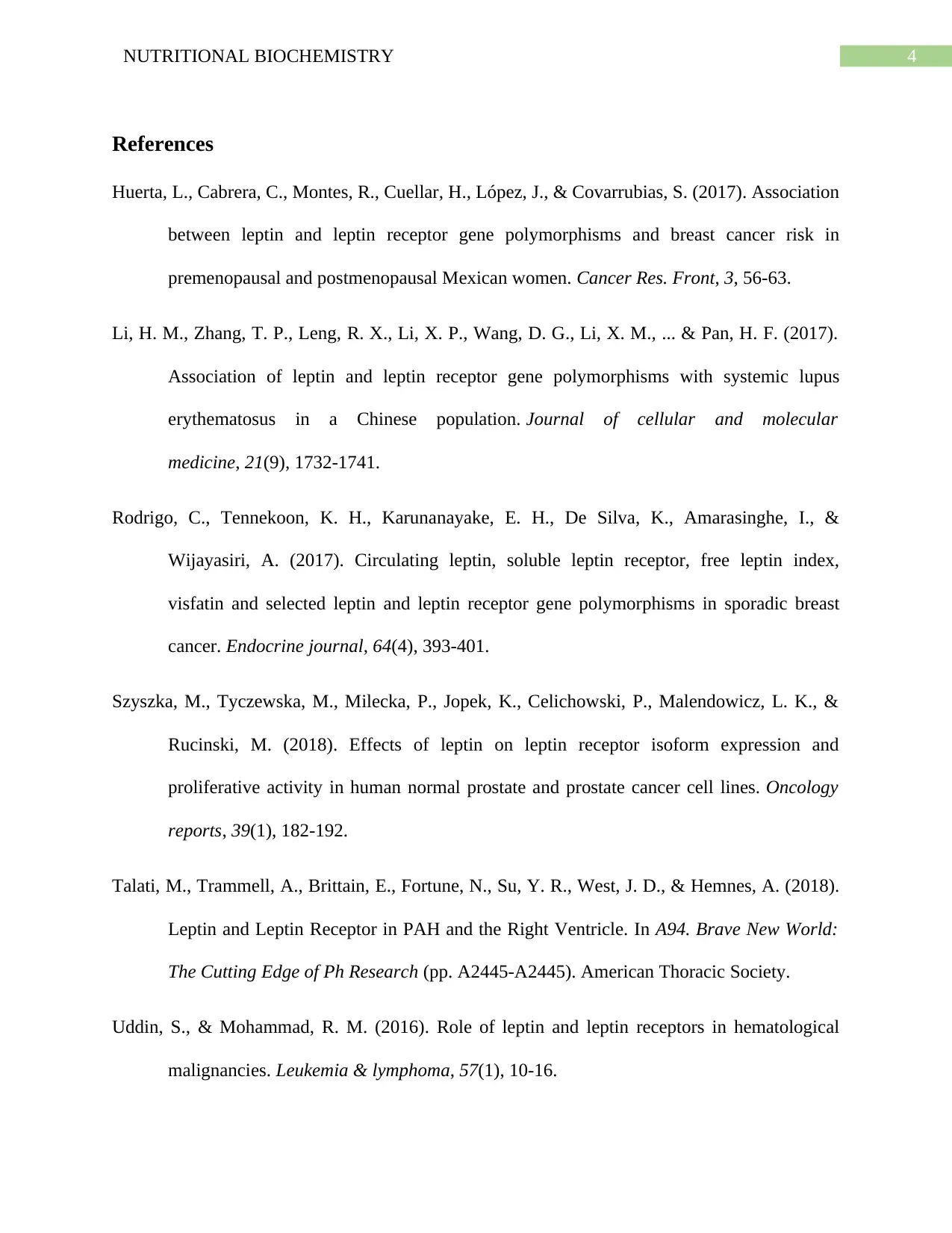
4NUTRITIONAL BIOCHEMISTRY
References
Huerta, L., Cabrera, C., Montes, R., Cuellar, H., López, J., & Covarrubias, S. (2017). Association
between leptin and leptin receptor gene polymorphisms and breast cancer risk in
premenopausal and postmenopausal Mexican women. Cancer Res. Front, 3, 56-63.
Li, H. M., Zhang, T. P., Leng, R. X., Li, X. P., Wang, D. G., Li, X. M., ... & Pan, H. F. (2017).
Association of leptin and leptin receptor gene polymorphisms with systemic lupus
erythematosus in a Chinese population. Journal of cellular and molecular
medicine, 21(9), 1732-1741.
Rodrigo, C., Tennekoon, K. H., Karunanayake, E. H., De Silva, K., Amarasinghe, I., &
Wijayasiri, A. (2017). Circulating leptin, soluble leptin receptor, free leptin index,
visfatin and selected leptin and leptin receptor gene polymorphisms in sporadic breast
cancer. Endocrine journal, 64(4), 393-401.
Szyszka, M., Tyczewska, M., Milecka, P., Jopek, K., Celichowski, P., Malendowicz, L. K., &
Rucinski, M. (2018). Effects of leptin on leptin receptor isoform expression and
proliferative activity in human normal prostate and prostate cancer cell lines. Oncology
reports, 39(1), 182-192.
Talati, M., Trammell, A., Brittain, E., Fortune, N., Su, Y. R., West, J. D., & Hemnes, A. (2018).
Leptin and Leptin Receptor in PAH and the Right Ventricle. In A94. Brave New World:
The Cutting Edge of Ph Research (pp. A2445-A2445). American Thoracic Society.
Uddin, S., & Mohammad, R. M. (2016). Role of leptin and leptin receptors in hematological
malignancies. Leukemia & lymphoma, 57(1), 10-16.
References
Huerta, L., Cabrera, C., Montes, R., Cuellar, H., López, J., & Covarrubias, S. (2017). Association
between leptin and leptin receptor gene polymorphisms and breast cancer risk in
premenopausal and postmenopausal Mexican women. Cancer Res. Front, 3, 56-63.
Li, H. M., Zhang, T. P., Leng, R. X., Li, X. P., Wang, D. G., Li, X. M., ... & Pan, H. F. (2017).
Association of leptin and leptin receptor gene polymorphisms with systemic lupus
erythematosus in a Chinese population. Journal of cellular and molecular
medicine, 21(9), 1732-1741.
Rodrigo, C., Tennekoon, K. H., Karunanayake, E. H., De Silva, K., Amarasinghe, I., &
Wijayasiri, A. (2017). Circulating leptin, soluble leptin receptor, free leptin index,
visfatin and selected leptin and leptin receptor gene polymorphisms in sporadic breast
cancer. Endocrine journal, 64(4), 393-401.
Szyszka, M., Tyczewska, M., Milecka, P., Jopek, K., Celichowski, P., Malendowicz, L. K., &
Rucinski, M. (2018). Effects of leptin on leptin receptor isoform expression and
proliferative activity in human normal prostate and prostate cancer cell lines. Oncology
reports, 39(1), 182-192.
Talati, M., Trammell, A., Brittain, E., Fortune, N., Su, Y. R., West, J. D., & Hemnes, A. (2018).
Leptin and Leptin Receptor in PAH and the Right Ventricle. In A94. Brave New World:
The Cutting Edge of Ph Research (pp. A2445-A2445). American Thoracic Society.
Uddin, S., & Mohammad, R. M. (2016). Role of leptin and leptin receptors in hematological
malignancies. Leukemia & lymphoma, 57(1), 10-16.

5NUTRITIONAL BIOCHEMISTRY
Yang, M., Peng, S., Li, W., Wan, Z., Fan, L., & Du, Y. (2016). Relationships between plasma
leptin levels, leptin G2548A, leptin receptor Gln223Arg polymorphisms and gestational
diabetes mellitus in Chinese population. Scientific reports, 6(1), 1-6.
Yang, M., Peng, S., Li, W., Wan, Z., Fan, L., & Du, Y. (2016). Relationships between plasma
leptin levels, leptin G2548A, leptin receptor Gln223Arg polymorphisms and gestational
diabetes mellitus in Chinese population. Scientific reports, 6(1), 1-6.
⊘ This is a preview!⊘
Do you want full access?
Subscribe today to unlock all pages.

Trusted by 1+ million students worldwide
1 out of 6
Related Documents
Your All-in-One AI-Powered Toolkit for Academic Success.
+13062052269
info@desklib.com
Available 24*7 on WhatsApp / Email
![[object Object]](/_next/static/media/star-bottom.7253800d.svg)
Unlock your academic potential
Copyright © 2020–2025 A2Z Services. All Rights Reserved. Developed and managed by ZUCOL.




